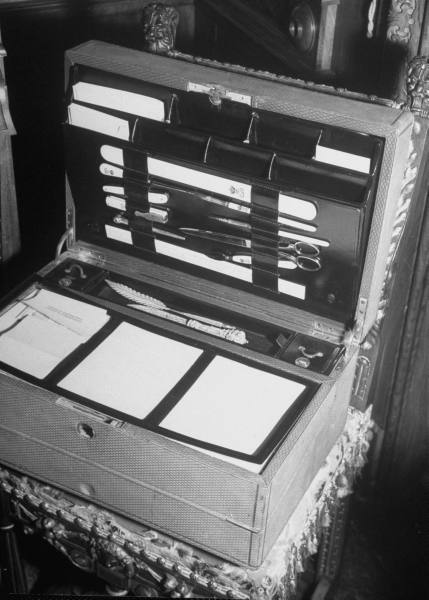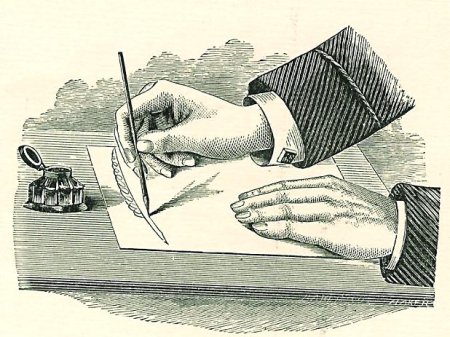
Over the years here at the Art of Manliness we’ve sung the praises of the handwritten letter and simply writing things out by hand in general. Typically, when folks think about writing a handwritten note, they imagine doing it in cursive. Perhaps it’s because we’ve all seen movies set in times past where people open up handwritten letters to reveal a note filled with handsome script.
Whatever the reason, I know a common refrain we hear with these posts is that many people feel their cursive handwriting is atrocious, to the point that it’s illegible. And when we get letters in the mail from readers, many of them begin with, “Sorry for my bad handwriting. This is the first time I’ve written in cursive since second grade.”
With schools spending less and less time on cursive handwriting (and sometimes doing away with penmanship lessons altogether), and our increased reliance on keyboards to communicate, it’s understandable that most people aren’t getting much practice writing things out by hand.
It’s easy then to dismiss the decline in penmanship as a non-problem, but there are a surprising number of people who do wish their handwriting was better. And there actually are a few reasons you might consider joining their ranks. Today we’ll discuss those reasons, as well as how to improve your cursive penmanship.
Get out your inkwell, sharpen your quill, and let’s get started.
The Rise and Fall of Cursive Penmanship
Ever since written text came into existence, there has been a class of individuals who specialized in handwriting — scribes, penmen, etc. And every age had a unique handwriting style. Monks in the 8th century gave us the Carolingian script with its bold, easy-to-read letters. During medieval times, the legibility of Carolingian script gave way to the more indecipherable “black letter” script. Renaissance scribes and writers returned to the Carolingian style, but made it look a bit more ornate by slanting it and connecting some of the letters with lines. Because this type of script originated in Italy, it became known as “italic.”
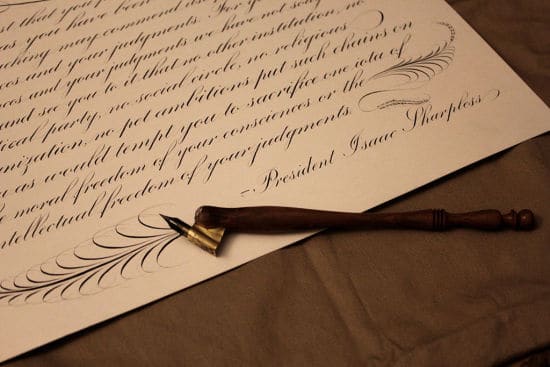
Copperplate script
The 16th century ushered in a more ornate style of handwriting called “copperplate” – so dubbed because students used engraved plates to learn to write it. Copperplate incorporates all sorts of loops and capital letters with unique flourishes, and was used to pen the Declaration of Independence.

Spencerian script
With the rise of literacy in America, a more systematic way of teaching handwriting was needed. Enter Platt Rogers Spencer. Spencer used nature to teach penmanship — water worn pebbles served as his model for ovals and the waves on a lake served as the inspiration for the lines that connected his letters. Spencerian script was a simple, yet elegant form of cursive handwriting that focused on legibility and ease of writing. Beginning in the 1830s, Spencer developed a system to teach his script that included over 100 question and answer catechisms on how to draw each line and curve in his particular style. By 1850, Spencerian cursive was the standard writing system throughout America.
After his death in 1864, students of Spencerian penmanship began to make the style even more ornate by adding in flourishes, shaded strokes, and extra ovals. This fancy style of Spencerian cursive became extremely popular and can still be seen today among professional penmen (like Jake Weidmann).

Palmer script
During the early years of the twentieth century, a handwriting instructor named Austin Palmer realized that while the loops and flourishes made Spencerian cursive look nice, it wasn’t very practical or efficient for the growing amount of bureaucratic paperwork that faced bookkeepers, accountants, and other businessmen. Moreover, it had become overly complicated to teach, especially to children. He also observed that Spencerian cursive primarily used finger movement to write all the letters, which often led to cramped hands.
To solve these problems, Palmer modified the Spencerian system in the following ways: First, he simplified the letters and got rid of the flourishes. In many ways, this was a return to the original cursive that Spencer taught. Second, he simplified and condensed the teaching of cursive — no more complex catechisms. Finally, he introduced “whole hand movement” to combat the fatigue and hand cramping that came with finger-only writing. Given these benefits, the Palmer Method became the standard way of teaching penmanship well into the 1960s.
Since then, several other systems of cursive have been developed, all with the goal of simplifying how it’s taught. D’Nealian script was the most popular (and the one that I learned as a child). Developed in the 1970s by Donald Thurber, D’Nealian script was a way to help children transition from manuscript (block letter) writing to cursive. While it’s easy to learn, it’s certainly not as nice looking as Spencerian or even Palmer cursive.
Up until the early 1990s, teachers in schools across America spent a great deal of time on penmanship. But with the rise of computers, the amount of time spent on penmanship began to decrease in the U.S. (From what I read, this didn’t happen in Europe to the same extent. If you’re a younger reader from Europe, let us know if you had rigorous penmanship lessons in school.)
Fast-forward to today. With increasing pressure to meet federal and state test standards, many schools have dropped teaching cursive handwriting completely. Besides the pressure to spend more time preparing for standardized tests, school districts have also dropped penmanship from their curriculum because they feel it’s no longer necessary in our world of computers, tablets, and smartphones.
Why You Should Bring Back Cursive Handwriting and Improve Your Penmanship
While we’re certainly spending more time communicating with our digital devices, I think there’s a case to be made as to why we shouldn’t give up on good old-fashioned cursive handwriting and why we should all strive to improve our penmanship:
Writing things by hand makes you smarter. Research shows that writing things out by hand can help improve general learning. One study out of the University of Indiana scanned the brains of a group of four and five-year-olds and found that neural activity was about the same amongst all of them. The researchers then split the kids into two groups: one group was shown letters and instructed to recognize them visually, and the other was taught to write them. The researchers scanned their brains again and discovered that neural activity was now dramatically different between the two groups. The kids who were taught to recognize letters visually showed no change in neural activity, while the kids who learned how to write letters showed more “adult-like” activity in their brains’ reading network.
Researchers believe there’s something about manually manipulating and drawing out two-dimensional shapes (like letters) that aids in learning comprehension. Studies have noted similar brain boosting results from handwriting practice in adults.
What’s more, other studies show there are cognitive benefits that come with cursive writing in particular — such as improved reading and spelling scores — that you don’t get when writing block letters.
Anecdotally, I’ve seen the power of handwriting (particularly cursive handwriting) boost learning in my own life. Whenever I get stuck on an idea, I naturally turn to pen and paper to work out the problem. I did this in law school when I was having trouble grasping a difficult legal concept. I’d just get a legal pad and start writing in cursive, and 9 times out of 10, after thirty minutes or so, clarity came.
I still do this exercise today, and don’t even have to think about it. When I’m having a hard time expressing myself via the keyboard, out comes my notebook and Pilot pen and I start writing things out by hand. For example, my posts on anti-fragility, the OODA Loop, and much of the Manhood series we published earlier this year were handwritten and then transcribed onto the computer. Those topics were hard nuts to crack, so I naturally went to pen and paper, after which the words and thoughts began flowing. I always make these notes in cursive; for whatever reason, I don’t get the same effect when I use manuscript.
Of course simply writing things down isn’t enough – if I had really crappy penmanship, I wouldn’t have been able to transcribe those handwritten pages!
Writing with pen and paper is convenient. While I have some really handy note-taking apps on my smartphone, they’re still clumsy to use compared to a pen and a pocket notebook. With my smartphone, I have to enter my homescreen passcode, navigate to my note-taking app, and type in my note using those tiny keys – all while struggling with autocorrect. Even with voice recognition capabilities, taking notes is still frustrating. With a notebook and manual writing tool, you just put pen to paper and you’re done.
Again, if my handwriting was so horrible that I couldn’t even read it, my writing would be in vain. Poof! — there go those spur-of-the-moment ideas.
Pen and paper don’t need batteries. Part of the convenience of pen and paper is that they don’t require batteries, so you never have to worry about losing power while you’re in the middle of writing something out.
Good penmanship truly saved my academic rear end when I was in law school. Somehow I mixed up the time for my Civil Procedure II final exam. I thought it was in the afternoon, so I strolled into the law school building in the morning to get some study time in before the test. But when I walked by the room where my exam was going to be, I saw my entire Civ Pro class sitting there getting exam instructions! I rushed in and was told by the proctor that it was too late to get my laptop out. I’d have to handwrite my exam. Three hours of handwriting!
Luckily, I had kept up with regularly writing in cursive so my handwriting was legible, and I could do it quickly without getting hand cramps. Ended up making an A-. Score one for penmanship.
Cursive writing is easy on the hand. As attested by my exam example above, when done correctly, writing in cursive is much less tiring than writing in manuscript. Remember, one of the reasons cursive was developed was to make writing for long periods of time easier. I’m able to write in cursive for over an hour in my journal sometimes without feeling any fatigue or cramping in my hand.
Writing by hand makes your messages more personal. While there’s a general form to cursive handwriting, your handwriting will develop its own unique personality and idiosyncrasies. Thus, when you handwrite someone a letter, they’ll be able to see you through your handwriting. When you get notes from your grandparents, parents, and other loved ones, you immediately recognize their distinct style, and it triggers a feeling of warmth and connection. That doesn’t happen with emails or text messages.
What’s more, handwriting allows you to convey emotion that you can’t with computer text. For example when we’re angry, we have the tendency to press down harder on the paper with our pen and to write faster. Consequently, your writing will appear darker and more mushed together and squibbly. Also, for some reason, emotional phrases like “I love you” come across much more genuine in handwriting than in the digital strokes of a computer; perhaps because we know it took real, personal effort rather than just the punching of a few keys.
Cursive writing just looks nice. It’s a pretty superficial reason, but a letter written out in nice cursive is just aesthetically pleasing. We get letters every week from AoM readers and while we love and appreciate them all, I’ll admit that the letters written with cursive stand out the most.
And while I use cursive to write in my journal for its ease, I also do it because it just looks nice and timeless.
People judge the quality of your ideas by the quality of your handwriting. This is related to the previous point. While you’d think people would judge the quality of an idea on the content and not the way it looks, studies show that’s not the case. One study demonstrated that in a classroom setting, good handwriting can take a generic test score from the 50th to the 84th percentile! If you’re looking for an easy way to bump up your essay exam scores without having to know more about the topic, just work on improving your handwriting. Better yet, write your exam in nice cursive.
You need to know cursive so you can read historical documents. An important reason for kids to learn cursive is so they can read historical documents like the Declaration of Independence or just old letters from their ancestors. I don’t want my kiddos going through the old letters or journals that Kate and I have from grandparents and great-grandparents and not knowing what they say. So even if our kids’ schools don’t teach cursive, we’re going to do it at home.
It’s meditative. We’re big proponents of journaling around these parts. While I’ve experimented with digital journals, I keep coming back to my trusty paper journal. And I think it has to do with the meditative qualities handwriting has, particularly cursive writing. Synchronizing continuous hand movement with thought puts me in a state of flow that I can’t get with typing or even writing block letters. Whenever I’m typing, I have a tendency to second guess myself and hit “delete” when a sentence doesn’t come out right. Because there’s no delete button with cursive handwriting, I spend less time judging what I’m writing and more time just getting lost in the process. The result is a feeling of calmness and flow.
How to Improve Your Cursive Penmanship
So you’ve been inspired to improve your cursive penmanship. Below I’ve complied some general tips to help you get started. Really, the best way to improve your cursive is to practice every single day. There is no royal road to good penmanship!
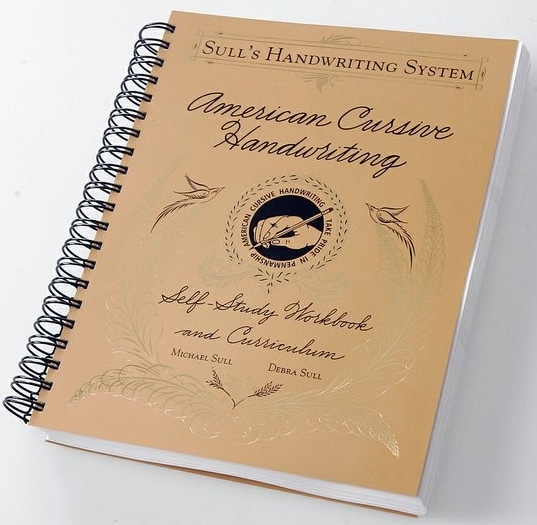
Buy a handwriting course book. While I can provide some general tips on how to improve your handwriting, the best way to do it is to go through a handwriting course book that has daily exercises. The best one that I’ve come across is American Cursive Handwriting by Michael Sull. It’s a big ol’ book that takes you through the paces on this style of script. American Cursive is a practical system of handwriting based on the Palmer Method and is great for everyday use like writing in your journal, writing a letter, or even writing law school exam answers. What’s great about American Cursive is you don’t need a fancy calligraphy pen, fountain pen, or quill. It works great for pencils, ballpoint pens, gel pens, etc. (We’ll be doing a series of posts in early 2015 about the wonders of the fountain pen. Stay tuned.)
If you’re looking to learn fancier script, pick-up an instruction manual on the Spencerian style. One that I’ve used with limited success (due only to my lack of effort!) is the original book that taught Spencerian penmanship. You’ll learn all sorts of cool flourishes that will make your writing look like important historical documents.
You can also find several free cursive handwriting lessons online. Here are a few good ones that I’ve come across:
- Peterson Handwriting (this is the best online resource I’ve found)
- Donna Young Cursive Handwriting
Review your letters. If it’s been ages since you’ve written cursive, it’s time to review your letters. Check out one of the sources above to brush up on their unique shapes and flourishes.

How to hold your pen (quill pen not necessary)
Hold your pen correctly. Your penmanship will never reach its full potential if you don’t hold your pen the right way. Grip your writing utensil so that it’s resting on your middle finger and hold it in place between the thumb and index finger as shown in the illustration. Keep your grip loose on your pen or pencil. If your fingernails are white, you’re squeezing too tight. A tight grip will lead to a tired hand, and handwriting that looks stiff and stilted.
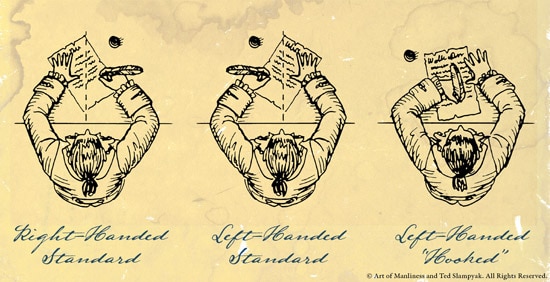
How to position your paper
Position your paper correctly. Proper paper placement is key for effective handwriting. If you’re right-handed, the top right and bottom left corners of your paper should line up in a straight line with your nose, as seen in the illustration. Your left arm holds your paper still. If you’re left-handed, flip the above instructions. If you’re a lefty that’s gotten used to the “hooked” writing hand position, handwriting expert Michael Sull suggests that you try the standard position, as it’s more comfortable for longer writing sessions.
This paper position facilitates proper letter slant in your handwriting. Ideally, letters should slant up and to the right by 35 degrees. If the above paper position doesn’t facilitate that, adjust the paper until it does.
Stay in the “writing zone.” The “writing zone” is the four-to-six inch area between your hands when they’re in the position as described above. Your writing hand will naturally rest in this area as you write.
The problem is that as you move your hand left to right as you write and as you move down the page, your writing hand will eventually exit the “writing zone.” Instead of straining and contorting your body, arm, and hand in order to continue writing, you simply need to move the paper with your non-writing hand as you work your way down the page. This way you’ll stay within the writing zone.
To do this, Sull suggests the following technique:
“Before starting to write, shift the paper to the right until the left side of the paper is in the ‘writing zone.’ Then, after writing toward the right side of the paper for about two or three inches, stop, shift the paper to the left a few inches [with your non-writing hand], and continue writing for the next few inches. Then shift the paper as before and continue this process throughout to the end of the page.”
By shifting your paper instead of your body or hand, you’ll remain comfortable as you write, which leads to better looking handwriting.
Keep things loose and airy. A common mistake people make with their handwriting is that they press down too hard on the paper as they write. This leads to both hand strain and bad-looking handwriting. You don’t need to apply that much pressure with the pen or pencil as you write in order to create a nice crisp line. Focus on keeping things loose and airy instead. To help with that, when you make a curve stroke, think of it as part of an entire oval. So when you write a lower case “a” for example, even though you’re not actually making an oval, visualize the oval that your curve stroke would be a part of if you were making one, like this:
This simple visualization technique can help keep things nice and loose and consequently produce more graceful handwriting.
Movement exercises. Another thing you can do to help keep your writing loose and airy is to practice movement exercises every day. These exercises train your muscles for the movements you make when you’re actually writing.
Here are a few simple movement exercises you can do:
Connected ovals starting from the top:

Connected ovals starting from the bottom:

Connected curves:

When you do these exercises, really focus on maintaining an easy, light touch. Don’t tense up.
Move your whole hand and wrist for capital letters, your fingers just for lowercase letters. Most folks have a tendency to only use their fingers when writing. This leads to cramping in both your hand and in your handwriting. To avoid this, use a combination of whole hand and finger movements. On capital letters, focus on using your entire hand to write the letter; use just your fingers for lowercase letters. This practice will allow you to write longer without tiring as well as produce more graceful handwriting compared to just using finger movements.
Don’t write too fast. When you talk really fast, people have a hard time understanding you. The same goes for handwriting. When you write fast, your handwriting will become less and less legible. Don’t rush it. Focus on making neat, well-formed letters and words. Speed will come as you get the movements down.
Practice 20 minutes every day. As with everything in life, the key to successfully improving your penmanship is consistent practice. Set aside at least 20 minutes a day to practice your handwriting. Start off with five minutes of movement exercises, and then spend the rest of the time focusing on a letter. Better yet, follow the lesson plans set out in a handwriting book or online PDF.
Another way to get more handwriting practice is to write things out by hand more. Instead of a digital journal, switch to a pen and paper one; instead of sending emails to loved ones, write them an actual letter; instead of keeping your to-do list on your smartphone, keep it in a pocket notebook. You get the idea.
Another way to sneak in some handwriting practice while simultaneously working on improving your writing ability is to do copywork by hand. My favorite author to do copywork from is Jack London. I’ll just take excerpts from his writing and copy it in a notebook by hand. I get a dose of virile, manly inspiration while beautiful, graceful letters fill the page.
Listen to our podcast on the power of penmanship:



